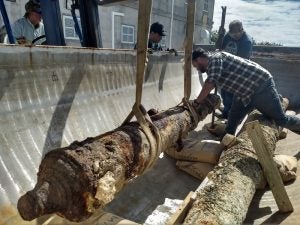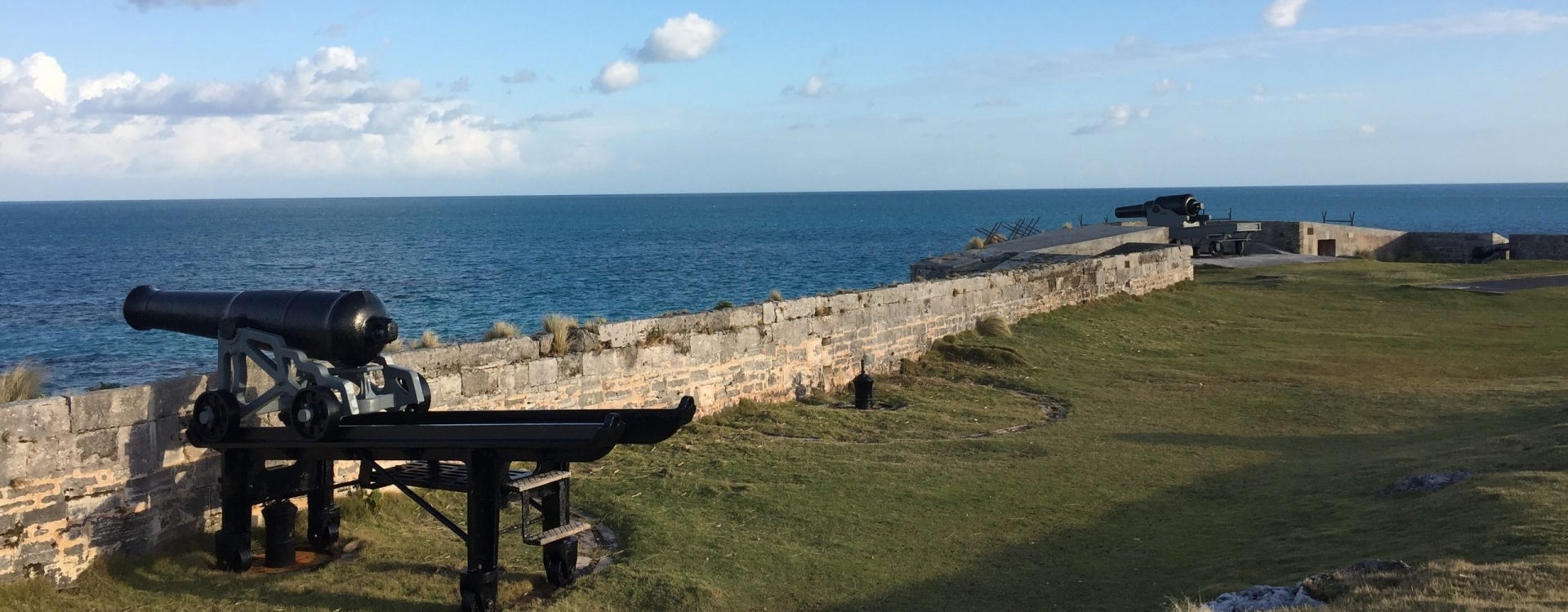National Museum of Bermuda
ECU/National Museum of Bermuda Partnership
The National Museum of Bermuda (NMB), formerly the Institute of Maritime History and Archaeology (IMHA) of the Bermuda Maritime Museum (BMM) from 1974-2013, is a not-for-profit charity situated in Bermuda’s largest fort at the Royal Navy Dockyard, the Keep. It “actively promotes the preservation, understanding and enjoyment of Bermuda’s cultural heritage through education, stewardship, historical, archaeological & scientific research, exhibition, acquisition, public outreach and advocacy” (National Museum of Bermuda 2022). NMB continues to pursue its mission and build itself up as a world-class museum and research facility by applying its core values of inclusiveness, relevance, engagement, integrity, excellence, and sustainability to every project. Since 1984, East Carolina University’s Program in Maritime Studies has been partnering with NMB to further its mission and help to preserve the natural and cultural history of the archipelago. ECU has signed and renewed Memoranda of Agreement with BMM or the NMB many times over the years, with the last agreement signed in 2018.
Field Projects
As a part of this larger partnership, students and faculty of the Program in Maritime Studies have contributed toward the protection and study of underwater cultural heritage in Bermuda through student projects, internships, theses, and field schools. These have been the result and instigation of numerous collaborative projects with new initiatives being developed each year.
* The content below has been compiled from a multitude of sources but may be incomplete. We welcome any additional information or correction of errors.
1984 – Civil War blockade running activities studied including preliminary surveys of Mary Celestia and Montana (Dr. Gordon Watts, Dr. William N. Still, and students).
1986 – Survey of American Civil War era Nola and preliminary excavation of unidentified wreck known as New Old Spaniard (Dr. Gordon Watts, Brad Rodgers, and students)
1987 – Re-excavation (the first disturbance being from non-archaeological salvage operations in the 1960s) and documentation of the remains of New Old Spaniard (Dr. Gordon Watts, Brad Rodgers, and students)
Jonathan W. Bream – Archival research for IMHA (individual project).
1988 – Initiation of the Bermuda in the Age of Exploration project, including magnetometer and visual survey discovering 22 new sites representing 15 shipwrecks, mapping, photography, and partial excavation of New Old Spaniard, and conservation of recovered remains from New Old Spaniard (later identified as 17th century Dutch) and San Pedro (Dr. Gordon Watts, Brad Rodgers, and students).
1989 – Mapping and excavation of an unnamed 16th or 17th century shipwreck discovered during 1988 field work (Dr. Gordon Watts, Brad Rodgers, and students).
1990 – Continued excavation, mapping, and photography of the 1989 site, now designated IMHA3 (Dr. Gordon Watts and students).
1991 – Continuation of detailed mapping and excavation of site IMHA3. The entire remains were raised by an international team led by ECU after which conservation efforts were begun. Supported by research in the Archives of the Indies in Seville, Spain, the remains were thought to be either those of La Viga or Santa Lucia (summer) (Dr. Gordon Watts and students). In the fall of the same year program students were involved in the drawing and cleaning of recovered timbers from IMHA3 in addition to general survey for new wreck sites in the area, and Victoria Schneider completed an internship at the Bermuda Maritime Museum.
1992 – Towed diver and magnetometer survey to re-locate previously known sites, in addition to search, recording of geospatial location, site map sketching, and photography of 35 new sites. Other field season activities included test excavations on a 16th century wreck site that had been previously looted and aiding BMM with archival research, photograph development, and conservation (Dr. Gordon Watts and students).
Government of Bermuda issues a limited-edition $50 note commemorating the Columbus voyages, the reverse side of which included an illustration of the IMHA3 site remains, now also known as the Western Ledge Reef wreck (16th century Spanish), drawn by ECU graduate students.
1993 – Mapping, photography, and other documentation of the previously looted remains of an unnamed 18th century British vessel on the Western Reefs of Bermuda that was located during the 1992 field season. Wood samples, sediment samples, and some artifacts recovered to aid dating and analysis (Dr. Gordon Watts and students).
1995 – Monitoring of sites from the 1992 and 1993 field seasons. Survey of the Bermuda reef complex for new sites. Relocation, mapping, and photographing of the Stonewall wreck near Western Blue Cut, Bermuda as well as recovery of some artifacts to aid in dating the site. Additional field season activities included aiding BMM with archival research and conservation (Dr. Gordon Watts and students).
1996 – Continued mapping and new excavation of Stonewall site in addition to archival research regarding the wreck and recovery of some of its artifacts to aid dating. Remains of L’Hermanie were also mapped and artifacts recorded in situ. Additional activities include tow board survey along nearby reefs for new sites and assisting BMM with conservation (Dr. Gordon Watts and students).
1997 – Completed excavation of the Stonewall wreck, now identified as 17th century Spanish or British, along with tow board survey resulting in the discovery of 2 new sites nearby. Additional archival research was also conducted at the Smithsonian regarding Herminie (L’Hermanie) (Dr. Gordon Watts and students).
1998 – Visit of previous field school sites, tow board and magnetometer survey to discover or relocate 3 new sites. Also aided BMM digitizing shipwreck maps and conducting archival research (Dr. Gordon Watts and students).
1999 – Archival research relating to and excavation, photographing, and mapping of 18th century Bermuda Sloop Hunter Galley in addition to a phase II survey and mapping of composite ship, possibly HMS Ready, St. George’s Harbor (Dr. Gordon Watts and students). Bermuda Maritime Museum agreement with ECU renewed.
2000 – Mapping and excavation of an 18th-19th century ship, first located during the 1996 field season
2001 – Dr. Edward Harris, Executive Director of the BMM, and Clifford Smith, Conservator and Archaeologist at BMM, participated in the planning of the Coastal Studies Center to be put on Roanoke Island, NC.
Completed excavation and mapping of the Iron Knee wreck, likely 18th century Bermuda sloop located in 1996 and partially recorded in 2000.
2002 – Student Jason S. R. Paling with BMM and Vanderbilt University conducted historic research, collected oral histories, photographed historic whaling stations, and took measurements of a surviving section of a historic Bermudan whaling vessel for Paling’s MA thesis.
2007 — Dr. Nathan Richards and Dr. Bradley Rodgers, along with Mark Keusenkothen and Joe Hoyt complete the assessment of an unidentified harbor wreck at the Royal Navy Dockyard identified as a steam lighter. The work was done due to the sunken ship’s proximity to a planned expansion of cruise ship docking area.
2008 – In the spring, Dr. Nathan Richards, Calvin Mires, Joseph Hoyt, and Peter Campbell would complete a contract on the “Myer’s Slip” vessel, identified as either HMS Medway or HMS Medina, as a part of a contract with the Government of Bermuda. In the summer Dr. Bradley Rodgers and Dr. Nathan Richards would lead a phase II pre-disturbance survey of Emily A. Davies (1876) and Norrköping (1869), Black Bay, Great Sound. In the fall of the same year, and as the culmination of preparation and other initial work since summer 2007, survey for and mapping of sites in Grotto Bay, Mullet Bay, Convict Bay, and areas adjacent to Myer’s Slip. Field school students record three wrecks and collect corrosion measurements at the site of Taifun and a Medina-class gunboat (either HMS Medway or HMS Medina), all as part of the Wrecks and Wrecking in St. George’s Parish project (Dr. Nathan Richards and Dr. David Stewart), an examination of historic ship salvage in the east end of Bermuda.
2012 — Nicole Wittig helps the National Museum of Bermuda (NMB, formerly BMM) to conserve artifacts for the new exhibit “Shipwreck Island” (internship).
2014 – Dr. Gordon Watts, co-founder of the ECU Program in Maritime Studies, releases his book Shipwrecked: Bermuda’s Maritime Heritage through the National Museum of Bermuda Press. The same year, Dr. Rodgers, Dr. Stewart, and Dr. Jason Raupp complete measurement, mapping, and some excavation of the Morgan’s Island wreck (17th-18th century) including collection of small number of endangered artifacts. Other activities included collection of photogrammetry models of terrestrial resources such as cannon and bastions as part of student Katie Clevenger’s research with NMB in Ely’s Harbor, west end (summer).

ECU graduate students help lower cannon into conservation tank for treatment.
2017 – Dr. Bradley Rodgers, Dr. David Stewart, along with Dr. Jason Raupp, and Jason Nunn completed archaeological examination of a possible 17th century Dutch pinnace site known as the Morgan’s Island Wreck. This work was completed as part of the Maritime Program’s summer field school and focused on archaeologically examining, mapping and recording the exposed sections of the wreck.
2018 – Dr. Bradley Rodgers lead a team of students to assist with conservation treatment of five (5) cannons recovered in 2017 during work at Hunter’s Wharf, St. George’s. The cannons, on permanent loan to the Maritime Museum from the Corporation of St. George’s, were digitally documented and prepared for electrolysis treatment as part of an Advanced Conservation course.
References
National Museum of Bermuda
2022 About Us. National Museum of Bermuda <https://nmb.bm/about-us/>. Accessed 23 February 2022.
